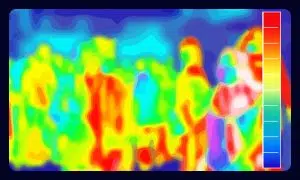Near the end of the 20th century, increasing power levels became the primary challenge in system design, which triggered a complex response from electrical, mechanical and material engineers. The combination of thermal measurements and thermal simulation helped achieve thermally aware system designs. However, no real solution was known for the valid comparison of thermal design … [Read more...]
Calculation Corner: Advective Thermal Resistance
A previous Electronics Cooling article, which discussed the process for analyzing the thermal performance of cooling fans [1], mentioned the need of accounting for the increasing coolant temperature as air passes through a heat sink. That article used an ‘average’ air temperature, which was defined as the midpoint between the inlet and outlet air temperatures. This article … [Read more...]
Better Cooling by Removing Material, Instead of Adding Material, to Unlock the Full Power of GaN Electronics
As society is moving from fossil fuels to more sustainable electrical power, the systems for converting and delivering this electrical power are becoming increasingly important. These power electronic systems are responsible for controlling and shaping the electricity between the sources, such as solar and wind, and the end-use destination, such as driving a motor or charging … [Read more...]
Superior Thermal Transfer from New Form-In-Place Gap Filler
Fujipoly® America announces the release of its new SARCON® SPG-70A. It is a high flow rate, high heat transferring compound that exhibits a thermal conductivity of 7.0 W/m°K and has the lowest thermal resistance among our dispensable SPG products. When applied between heat-generating components and a nearby heat sink or spreader, the form stable thermal material completely … [Read more...]
Why Chemical Compatibility Is Vital To Your Liquid Cooling System
Power densities in electronic subsystems continue to increase, driving demand for more extreme cooling power alternatives that increasingly include liquid cooling as a viable candidate. To optimize thermal management efficiency, sustainability and reliability, designers of systems that use liquid cooling are exploring innovative combinations of component materials, including … [Read more...]
- « Previous Page
- 1
- 2
- 3
- 4
- 5
- …
- 13
- Next Page »








